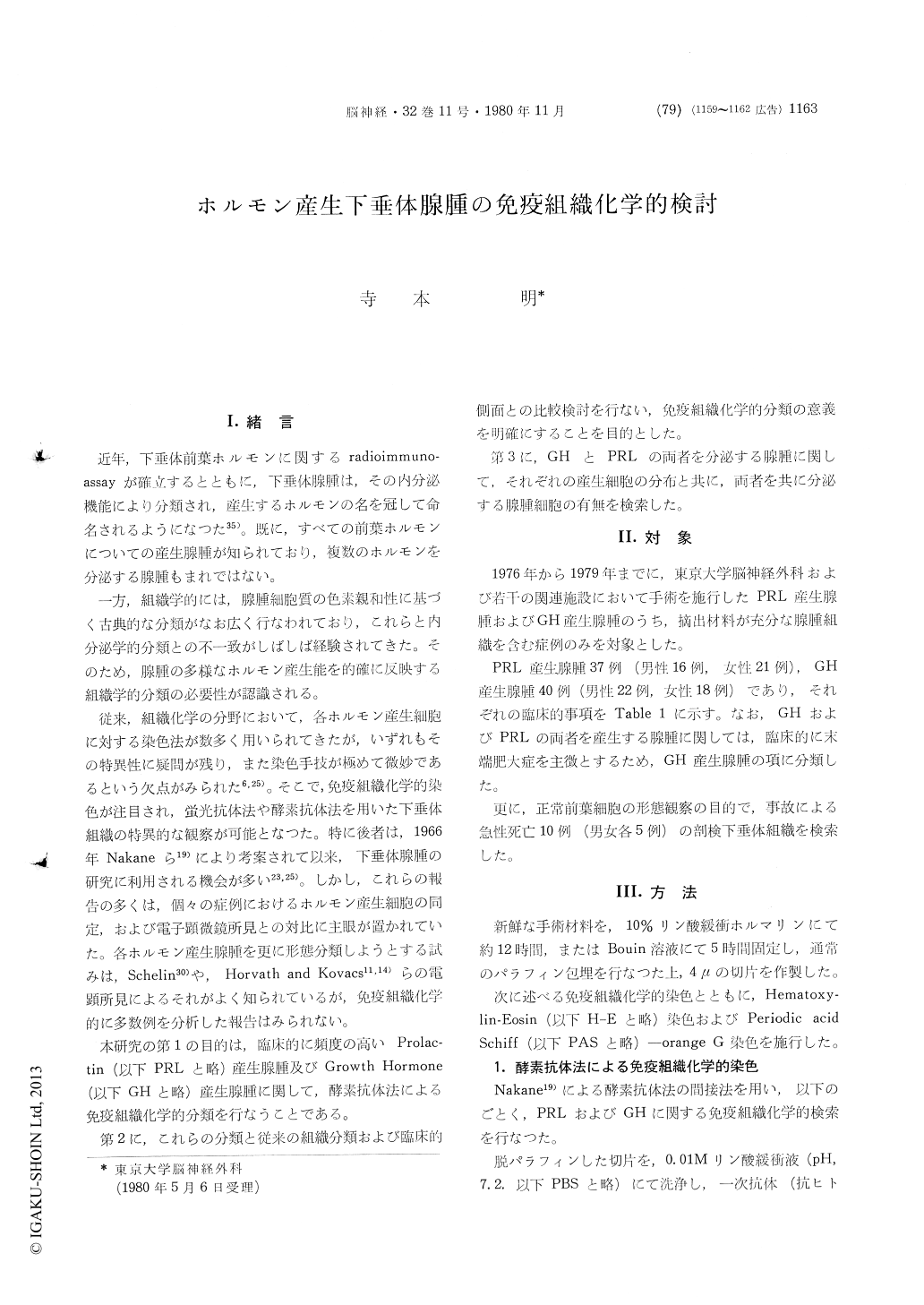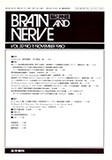Japanese
English
- 有料閲覧
- Abstract 文献概要
- 1ページ目 Look Inside
I.緒言
近年,下垂体前葉ホルモンに関するradioimmuno—assayが確立するとともに,下垂体腺腫は,その内分泌機能により分類され,産生するホルモンの名を冠して命名されるようになつた35)。既に,すべての前葉ホルモンについての産生腺腫が知られており,複数のホルモンを分泌する腺腫もまれではない。
一方,組織学的には,腺腫細胞質の色素親和性に基づく古典的な分類がなお広く行なわれており,これらと内分泌学的分類との不一致がしばしば経験されてきた。そのため,腺腫の多様なホルモン産生能を的確に反映する組織学的分類の必要性が認識される。
In an attempt to establish the immunohisto-chemical classifications of functioning pituitary adenomas, 37 prolactin (PRL) producing and 40 growth hormone (GH) producing adenomas were studied by peroxidase-labeled antibody method for the localization of PRL and GH. (Anti-human PRL and GH were supplied by NIAMDD.) The relations of these findings to the conventional classifications and clinical features were also investigated.
(1) PRL producing adenomas
With HE and PAS-orangeG stains, all the tumors were classified as chromophobe adenomas except for two, which were acidophilic. No specific features were found for these two cases.
Immunohistochemically, PRL producing adenomas were classified into two types according to the population of PRL cells and the intracytoplasmic localization of immunoreactive PRL.
Type I 29 cases
PRL was demonstrated in most tumor cells of this type of adenomas, suggesting to be the pri-mary PRL producing adenomas. Intracytoplasmic PRL was characteristically localized as a small perinuclear mass. Clinically, the adenomas of type I were found from microadenomas to large ones with suprasellar extensions. Serum PRL concent-rations increased significantly corresponding to the volume of adenomas.
Type II 8 cases
A few PRL cells were sparsely found in this type of adenomas. Intracytoplasmic PRL was demonstrated diffusely in each PRL cell, which resembled to that of anterior pituitary gland. Clinically, all of these adenomas showed suprasellar extensions, and serum PRL levels were mildly elevated, ranging from 33 to 107ng/ml (mean: 68.9). It was suggested that the interruption of PRL inhibiting factor might play some role to activate PRL cells of these adenomas.
(2) GH producing adenomas
With HE and PAS-orangeG stains, they were classified as acidophilic (10 cases), chromophobe (13 cases) and mixed (17 cases) adenomas. These con-ventional classifications, based on the staining affinity of the tumor cell cytoplasm, failed to pro-vide the correlations to serum GH concentrations, the stages of tumor growth and the immunohisto-chemical findings mentioned below.
Immunohistochemically, GH producing adenomas were also devided into two groups according to the population of GH cells.
Diffuse type 18 cases
GH cells, diffusely distributed, were the chiefcomponent of these adenomas.
Sporadic type 22 cases
A few GH cells were found sporadically in this type of adenomas.
In either type of adenomas, GH cells were round to polygonal in shape with immunoreactive GH throughout the cytoplasms. These findings were similar to those of GH cells in the anterior pituitary gland. Clinically, both types of adenomas were distributed from microadenomas to large ones, whereas the former type showed higher serum GH concentrations than the latter.
On the eight adenomas, which revealed the pre-sence of both GH and PRL, the localizations of these two hormones were studied by the double staining method and the mirror section technique. In most instances the respective hormones were demonstrated in separate cells, although a few cells were found to contain both GH and PRL.

Copyright © 1980, Igaku-Shoin Ltd. All rights reserved.


